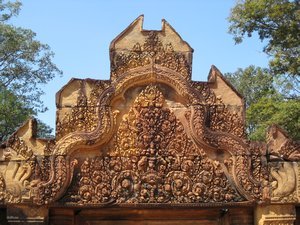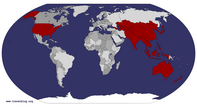Advertisement
Published: November 1st 2009

 image1
image1
Gate at Banteay SreiCambodia is about half the size of Germany (about as big as the state of Missouri). It is one of the poorest countries in the world and the literacy rate is approximately 35%. Infant mortality is over 10%, prostitution (sadly, child prostitution is very common) and disease (especially AIDS) are rampant. We started our anti-malarials here and there are signs warning against dengue fever (there is no vaccine or other prophylactic treatment other than bug spray). The history and people of this tiny country have already made a big impact on us. Below is a very over-simplified account.
Squashed between powerful neighbors (Siam/Thailand, Burma, Vietnam), Cambodia has been a sort of political ping-pong ball over the past several hundred years and especially so in the 19th and 20th centuries. In the 1800s, Cambodia sought protection from France, which had begun to colonize other countries in the region (Laos and later Vietnam). The French took over and ruled Cambodia until 1953 (the Japanese occupied Cambodia during WWII, committing many atrocities as they did elsewhere in SE Asia). Cambodia's borders were redrawn again in the 1950s and disputes, especially with Thailand, continue today.
After declaring independence in 1953, "Prince" Sihanouk took

 image2
image2
Banteay Sreiover the country. He was ousted in 1970 by the U.S., which was afraid of the support that he was receiving from the Chinese and Viet Cong (the U.S. bombed Cambodia heavily during the Vietnam War). Civil war followed and in this power vacuum, the horrific Pol Pot came to power in 1975. Over the next three years, this monster, in the name of Communism, proceeded to convert the country into a simple, uneducated, agrarian state. He emptied all of the cities and began a mass genocide, murdering somewhere between one and three million Cambodians (this included all educated people, anyone who wore glasses or could speak another language and, of course, anyone who opposed him). Pol Pot's rule came to an end when the Vietnamese invaded in 1978 and installed their own puppet government, led by Hun Sen (who is still prime minister today). Throughout the 80s and 90s, the government forces continued to clash with Pol Pot's Khmer Rouge, which was backed by the Chinese. Many more people died. As a result, you just don't see many older Cambodians - at all; an estimated 60% of the population today is under the age of 20.
Our guide,

 image3
image3
Monster carving at Banteay SreiCheak, was born in 1977. To avoid being forced into the military, he became a Buddhist monk for several years. Many members of his extended family have been murdered and his oldest brother, a solider, died fighting. Once when he and a cousin were making their way back from a wedding in the mountainous region close to the Thailand border, they were kidnapped by the Khmer Rouge, tied up and held at gunpoint while their bags were searched for anything that might possibly tie them to the government. They were eventually let go but Cheak still doesn't feel safe discussing politics, with anyone, in public.
We couldn't help thinking about our own pampered teenage years where our biggest challenges were acne and the SATs. It's very sobering.
On our second day of temple touring, Cheak picked us up at the Kool Hotel and we drove about 24 miles away from the main clump of temples to one called Banteay Srei. It's famous for two things:
First, it's very old, built in 967 AD (just let that one sink in for a minute - this temple is over 1,000 years old and we were walking around in it). The

 image4
image4
Banteay Sreiname means "Citadel of Women" or as Cheak called it "The Lady Temple" because of the many carvings of women found throughout (mostly dancers or Hindu mythological figures).
Second, it is the only temple in this are that was built from a specific type of pink sandstone that's extremely durable and so the carvings are just exquisitely preserved. There's an entire section of images that tells the Hindu story of Rama enlisting the aid of a monkey general to retrive his wife, Sita, who was captured and being held by an especially bad-tempered demon. The monkey generals are pretty cool.
The long drive from Banteay Srei back to the main cluster of temples go through several villages and many, many rice paddies. We stopped along the way and bought some baskets (made from bamboo and palm leaves) and gorgeous serving utensils made from coconut tree wood. Our bargaining skills are rusty and we probably didn't get much of a deal but that was OK with us since everything added up to less than 10 USD.
Pre Rup is a smaller temple which looks like a mini Angkor Wat and was finished in 961 AD. It's unusual in

 image5
image5
More wonderful carvings at Banteay Sreithat one of the building materials is brick. It also has very steep stairs (we were glad it wasn't raining; apparently the temples all get pretty slippery and many accidents have happened). There are excellent views from the top and we could see Angkor Wat's three tallest spires peeking out from the jungle cover.
After a quick but filling lunch ($8 US), we headed back into the hot sun to see a few of the smaller temples. One was being "restored" by the Chinese and it looked awful - big new stones were being stuck in right next to the older ones creating an ugly mismatched effect. Other temples have been restored mostly by improving the underlying support system so that doorways and ceiling don't fall down but the Chinese were apparently going for a less structural and more asthetic approach. We're not fans of it.
We ended the afternoon at the largest ruins of all, Angkor Tom. It's an enormous complex with five separate huge entrance gates and many buildings inside. By far, the most impressive is Bayon, a Buddhist temple built in 1190 AD, atop a previous Hindu site. The most amazing feature of this large

 image6
image6
Lotus flowertemple are the enormous Buddha faces engraved all over it. The detail is just incredible and we enjoyed exploring it.
The Kool Hotel has become a sanctuary for us and we relaxed there for a few hours. We've figured out that about two hours in the tropical sun is very do-able, three is pushing it and, after three, we both get cranky like two year olds in need of a nap (or, in our case, cold drinks and air con).
Around 6:30pm we took a tuk-tuk into town for drinks and dinner.
In 1998, a new constitutional government was formed which brought greater stability to the country - and tourism began again. Siem Reap is probably Cambodia's wealthiest town with a growing economy (based mainly on tourism). Still, the poverty is very apparent - kids persistently trying to sell you food, tour guides, trinkets "one dollar . . madam, you buy from me? One dollar. Very nice." Over and over again as they follow you into and out of the temples and up and down the streets of Siem Reap. The streets are torn up and must turn into impassble mud pits after storms. Most people live

 image6
image6
Angelique enjoying a coconut at lunchin simple wooden houses with thatched or corrugated steel roofs and cobras and scorpions are everywhere. We've heard that the situation in the countryside is much, much worse. Yet the people that we have interacted with (our guide, everyone in the hotel, the restaurants) have been the friendliest and nicest that we've met so far. We're amazed and humbled by them.
The Foreign Correspondents Club, the FCC, is a central gathering point for foreigners in town. In the words of our friend Alex, it has a "nice 1960s Miami kind of vibe" and could be lifted straight from a tony Miami or LA suburb. It's a gleaming all-white building with a large outdoor patio and bar next to a fountain. There is an excellent restaurant inside as well. Adrian tried a regional favorite, the Singapore Sling (verdict: ugh, too sweet!) and Angelique tried a rum drink with fresh passionfruit (tasty!). We caught another tuk-tuk to dinner at the Sugar Palm which is, hands-down, the best restaurant that we've been to so far on the trip (we're editing this several days later in Bangkok now and it's still the best restaurant).
Cambodia's signature dish is "amok", a kind of
fish curry. Chunks of fresh local fish from the nearby Tonle Lake are cooked slowly in a fabulous broth of coconut milk, ginger, lime juice and several other mysteriously delicious ingredients and served either in a small basket made of fresh banana leaves or a coconut shell. Angelique order this at almost every meal (along with a fresh coconut - they lop off the top and give you a straw to drink the juice inside - YUM!) and it was delicious every time but at the Sugar Palm it was just divine. If you ever find yourself in Siem Reap, you have to eat here! Adrian had an excellent pork curry and we both had the local beer. A memorable meal (and all for $20 US).
We have an early morning tomorrow and so headed back to the hotel after dinner and fell asleep listening to a little gecko chirping outside our room.
Advertisement
Tot: 0.042s; Tpl: 0.013s; cc: 8; qc: 23; dbt: 0.0207s; 1; m:domysql w:travelblog (10.17.0.13); sld: 1;
; mem: 1.1mb














